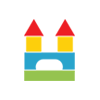Standard of Excellence
You have chosen an early childhood program for your child that is accredited by the National Association for the Education of Young Children.
NAEYC administers the largest and most widely recognized national, voluntary, professionally sponsored accreditation system for all early childhood schools and child care centers. NAEYC is the nation’s largest organization of early childhood educators.
Classroom
Beginnings Schools meet and exceed ratio requirements set by the Department of Early Learning.
Your child will be welcomed into a classroom most suitable to his or her age and readiness.
CLASSROOM - INFANT
- Age: 3 months - about 12 months
- Child to Staff Ratio: 3:1
CLASSROOM - TODDLER I
- Age:1 - about 1.5 years
- Child to Staff Ratio: 4:1
CLASSROOM - TODDLER II
- Age:1.5 - about 2.5 years
- Child to Staff Ratio: 5:1
CLASSROOM - PRESCHOOL I
- Age:2.5 - about 4 years
- Child to Staff Ratio: 9:1
CLASSROOM - PRESCHOOL II
- Age:4 - 5 years
- Child to Staff Ratio: 10:1
Curriculum
We believe that children learn through play and exploration.
Children process the world around them in a different way at each stage of their development. Our program recognizes the deep interplay between intellectual, emotional and physical abilities, and the need to develop all these through a rich blending of social interaction and individual exploration. Our curriculum creates an environment that engages, sustains and encourages children to participate in productive learning experiences. It is tailored to meet the unique and differing needs and similarities of young children.
At Beginnings we take great pride in a strong, developmentally appropriate curriculum, and a staff capable of putting it into action.
DEVELOPMENTAL GUIDELINES AND STANDARDS (BENCHMARKS)
It is well established that the earliest years are the most important learning years. A child’s brain at this age is making connections that will last the rest of their life.
The developmental domains developed by the Department of Early Learning are utilized at Beginnings to determine whether a child has reached developmental milestones and can accomplish the major associated tasks.
Using a portfolio method, evaluation of a child’s growth is gathered from a variety of sources and methods: parents, classroom observation, developmental assessment, and other appropriate tools. Systematic observation gives us a picture of where children are in their growth. Observing a child’s development can also provide valuable information, allowing us to design curriculum and environments; we adjust expectations so that all children can feel secure and successful in school.
SPECIAL ELECTIVES AND PROGRAMS
Betsy Dischel: Red Ukulele facilitates an interactive music class taught primarily in Spanish and American Sign Language with English support; hands-on instruments and large motor activities are introduced during each session. (Infant-Preschool; Tuesdays at Queen Anne, Wednesdays at Capitol Hill)
Music Class with Teachers Bonnie and Bruce: A music and movement class taught by local musicians; students are introduced to different music genres ranging from classical to jazz and traditional folk, and a variety of instruments, including: banjo, guitar, ukulele, violin. (Infant-Preschool; Wednesdays at Queen Anne, Thursdays at Capitol Hill)
What People Are Saying
It is great that this is a non profit daycare and there is a board that can be joined if one would like to implement change.
Because of the size of the school, teachers really get to know the students and that makes all the difference. They bring in musicians, bi lingual
teachers, field trips, parent events, etc. What I like the most is that I can call my son’s teacher at any time during the day and talk directly to her for an update.
We love the teachers and leadership…We’re big fans of Beginnings.
This is a safe, fun school with great food and facilities. My children feel safe and well cared for, and I feel
confident leaving my children here.
